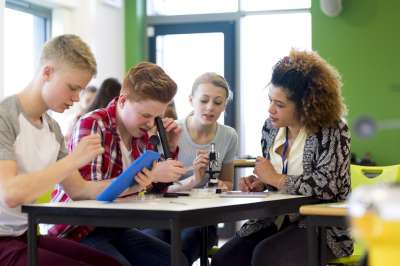TPS explained and demystified, with tips for new teachers and pros alike!
The think, pair, share strategy is a cooperative learning technique in which students think through questions using three distinct steps, encouraging individual participation. This is an excellent method for promoting critical thinking and articulate communication in the classroom.How Can You Stretch Students' Thinking?
This strategy often stretches students' thinking merely by its implementation. Some students consider it a challenge to articulate their thoughts to another person. However, once students become comfortable with this aspect, there are ways to expand the strategy's reach.
One way to is to be sure that students have opportunities to pair with a variety of partners. Pairing students who sit closest to each other is convenient but doesn't provide the same intellectual or social challenge as accommodating the learning and discussion styles of a variety of classmates.
Another method for varying the strategy is to allow two "pair" steps before proceeding to "share." Students can either participate in two consecutive pairings or can pair with one student and then the first pair can be grouped with another pair to discuss their thoughts before joining a whole-class discussion. This double-pair method is particularly helpful if you have a very large class or are dealing with an especially complex question.
When Can You Use It?
Reading/English
The think, pair, share strategy can be used to enhance discussions about specific characters in books. For instance, a group that is reading The Great Gilly Hopkins by Katherine Paterson might be asked to think, pair, share in response to the questions, "Would you be able to be friends with Gilly? Why or why not?"
Writing
The think, pair, share strategy can help students learn about the writing process. Students who are asked to choose a topic of their own to write about often become stuck. Teachers can make this process easier by asking early in the year, "Where do story ideas come from?" As students think about the question and discuss their ideas with a partner and then as a class, they usually come up with a long and valuable list of ideas that can take them through an entire year's worth of writing.
Math
The think, pair, share strategy works well when there are multiple correct answers to a given problem. This makes the strategy perfect for questions that involve estimation, patterns, logic, and so on. This strategy can also be used when students are deciding how to approach a problem rather than when they are settling on a specific answer to one.
Social Studies
Social studies content provides many opportunities to implement this strategy, especially when introducing new topics. Use the think, pair, share strategy by asking a question such as, "What do you already know about the Revolutionary War?" As students grapple with ethical topics, you might ask questions such as, "Would you have agreed to be a 'stop' on the Underground Railroad? Why or why not?"
Science
As students are conducting experiments, the think, pair, share strategy can be a way for them to form hypotheses or to discuss their interpretations of a given experiment. For instance, before an experiment on density, students might be asked to use the think, pair, share strategy when deciding which of a given set of items will float when placed in a tub of water.
Lesson Plans
Spelling Using Think, Pair, Share
This lesson asks students in primary grades to create a list of "short a" words for spelling using the think, pair, share strategy.
References
Cobb, P., Wood, T., Yackel, E., Nicholls, J., Wheatley, G., Trigatti, B., & Perlwitz, M. (1991). Assessment of a problem-centered second-grade mathematics project. Journal for Research in Mathematics Education, 22(1).
Pimm, D. (1987). Speaking mathematically: Communication in mathematics classrooms. New York: Routledge & Kegan Paul.
Pressley, M. (1992). Beyond direct explanation: Transactional instruction of reading comprehension strategies. Elementary School Journal, 92.513-555.















